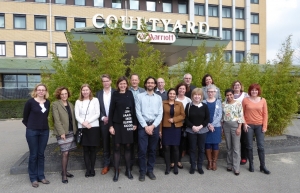Diagnosis and Management of Juvenile Myasthenia Gravis
- Number 242
- Date 1 March 2019
Location: Hoofddorp, The Netherlands
Title: Diagnosis and Management of Juvenile Myasthenia Gravis
Date: 1-3 March 2019
Organisers: Dr P. Munot (UK), Dr E. Niks (The Netherlands), Dr J. Palace (UK) and Dr S. Robb (UK)
Translations of this report by:
Dutch by Dr E. Niks
German by Dr A. Della Marina
Participants: Dr F. Baggi (Italy), Dr M. Borresen (Denmark), Dr P. Cruz, Dr A. Della Marina (Germany), Dr C. Erasmus (The Netherlands), Prof. A. Evoli (Italy), Prof. B. Eymard (France), Dr I. Hughes (UK), Prof. H. Jungbluth (UK), Dr A. Klein (Switzerland), Dr N. Kuntz (U.S.A.), Dr P. Munot (UK), Dr E. Niks (The Netherlands), Dr J. Palace (UK), Dr M. Pitt (UK), Dr S. Ramdas (UK), Dr S. Robb (UK) and Prof. M. Ryan (Australia)
The 242nd ENMC workshop was convened between 1 and 3 March 2019 and brought together a patient representative and neuromuscular experts from Europe, Australia and the United States to discuss the care of children with Juvenile Myasthenia Gravis. The aim was to develop guidance on diagnosis and management of Juvenile Myasthenia Gravis, after reviewing the latest evidence and collating expert opinion.
Juvenile myasthenia gravis (JMG) with onset of symptoms below the age of 18y, like its adult counterpart (MG), is a disorder of neuromuscular transmission, resulting from binding of acquired autoantibodies to components of the neuromuscular junction, principally the acetylcholine receptor (AChR). This results in fatigable weakness affecting skeletal muscles which may also include the swallowing and breathing muscles. Although rare, this condition is treatable, but if not treated appropriately JMG may be life threatening due to swallowing and breathing muscle weakness. Over the longer term, inadequate or inappropriate treatment may also be associated with significant disability and morbidity, with on-going limb weakness, steroid related side effects and permanent impairment of vision in children (amblyopia).
The recently published adult guidelines for myasthenia gravis1,2 are an excellent resource for treating adults, but the scope does not include detail on diagnosis and treatment of JMG. Although most of the current practice on diagnosis and treatment of JMG in children is extrapolated from adult trials and experience, there are important differences related to diagnosis and treatment of children with JMG Few paediatric neurologists treat enough patients with JMG to have adequate experience with all treatments and there is considerable variation in clinical practice between centres. The quality of care and appropriate and timely treatment of these children can influence the potential outcomes.
At the workshop, the discussion was focussed on some important differences related to diagnosis and treatment of children with JMG, such as exclusion of unrecognised congenital myasthenic syndromes, potential higher rates of spontaneous remission in JMG and the practical difficulties of thymectomy and plasma exchange in the young child. This group of international experts reviewed the available evidence, and agreed to develop a consensus guideline to optimise early diagnosis and treatment.
Various immunosuppressive drugs were also discussed and it was agreed that the best possible choice and timing of introduction needs to balance the risk of long-term neurological deficit against the risk of side effects in young children.
Various available outcome measures for myasthenia gravis in adults were discussed and there was agreement about the need for developing specific outcome measures that are clinically meaningful, validated and feasible in young children.
The need to develop national registries to collect longitudinal data on long-term outcomes and the effects of different medications/interventions in JMG was acknowledged. The participants agreed to champion local registries and collaborate in future research.
The workshop concluded by recognising that there are a number of areas where better evidence is needed both in diagnosis and treatment of JMG. Collaborative international effort is required to collect this evidence in children and a number of themes for future collaborative research were identified.
References:
1. Sanders DB, Wolfe GI, Benatar M, Evoli A, Gilhus NE, Illa I, Kuntz N, Massey M, Melms A, Murai H, Nicolle M, Palace J, Richman DP, Verschuuren J, P. International consensus guidance for management of myasthenia gravis: Executive summary. Neurology. 2016 Jul 26;87(4):419-25.
2. Sussman J, Farrugia ME, Maddison P, Hill M, Leite MI, Hilton-Jones D. The Association of British Neurologists' myasthenia gravis guidelines. Ann N Y Acad Sci. 2018 Jan;1412(1):166-169.

A full report is published in Neuromuscular Disorders (pdf)
